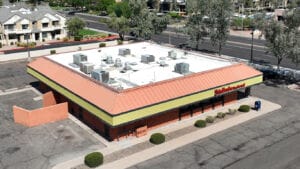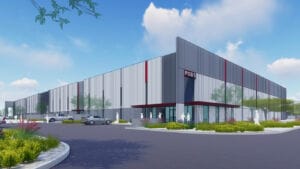You’ve heard it said: “The only thing constant is change.” My parents would say that, and I have learned change can be a hard pill to swallow. Many years later, I have also learned this saying applies to real estate, and perhaps more now than ever.
For at least two decades, redevelopment and urbanization have been a common trend. More recently, however, we have seen much more than remodels and building updates. Current trends are a complete change in use or repurposing of real estate. Examples may include converting unused retail space into office buildings, restaurants or mixed-uses with high-density residential. Even more creatively, U-Haul recently purchased an empty Kmart store located in South Mountain, which it intends to convert into a self-storage facility.

Adaptive reuse is making a big impact on commercial real estate and likely will for several years to come. According to the Urban Land Institute’s Emerging Trends in Real Estate (2019), the repurposing trend is likely to continue over the next decade. As real estate professionals, we had better be prepared to adapt.
Many of the changes are fueled by new technology and consumer preferences. While millennials may be the first to embrace these changes, it is becoming more common across all generations. Perhaps the most obvious changes are seen in the retail space. The impact of e-commerce has disrupted the typical brick-and-mortar stores that we grew up frequenting. Companies like Amazon, Walmart, and others are investing big dollars in online shopping and it’s working! Some real estate professionals believed this would cause a collapse of the brick-and-mortar stores, but stores are proving to be more robust than previously thought. Good retailers are looking for ways to limit their building footprint so they can provide other ways to buy their products (i.e., in-store, online, online with in-store pickup, using an app, etc.) – which has led to the concept of “omni-channel” marketing.
Adaptive reuse can be tricky, and there are several important considerations that arise in these transactions, particularly during the due diligence period. Below are some suggestions.
Use Restrictions
A careful review of recorded use restrictions and CC&Rs should be taken to ensure the proposed use is compliant. Sometimes prohibited uses can appear in the deeds themselves, which can be easily overlooked in the review process. Title review should be done at the due diligence stage or anytime a new use is being considered. For existing retail centers, careful attention should be given to review leases for specific use restrictions that may prohibit adaptive reuse of the property.
Zoning and Land Use
Having a clear understanding of zoning regulations and limitations on development is necessary for a successful repurposing project. Zoning attorneys provide valuable skills and information when working with municipalities and neighbors to help ensure the proposed project is approved.
Surveys
Title review should definitely include a review of an ALTA or NSPS survey, which will indicate easements and other potential restrictions. It is not uncommon to discover shared parking arrangements in mixed-use and larger developments, which could impact your proposed use.
Special Zones or Districts
Opportunity zones have become incredibly popular, and consideration should be given to whether your proposed use is within these zones. Municipalities also have adopted area-specific zones and districts, which could help or hurt your proposed use.
Building Code and ADA
Repurposing buildings will most likely trigger properties to conform to existing building codes and current ADA regulations. Architects and engineers can provide valuable insight and estimates on these costs, which can occur both onsite and offsite.
When it comes to embracing change in real estate, developers and property managers should not be afraid to think outside the box. Real estate trends are constantly changing, and only those who adapt will survive. If you stop and think about it, there may be adaptive reuses that complement and add value to your property.
Attorney Casey S. Blais is a shareholder at Burch & Cracchiolo, P.A.
High-profile adaptive reuse projects
The Valley is seeing a notable uptick on adaptive reuse and repurposing projects. The Circuit Tempe transformed a former semi-conductor plant into a modern, Class A office product, and the highly-visible Park Central redevelopment by Plaza Companies and Holualoa Companies is revitalizing Midtown. While those projects are two of the most visible in the Phoenix market, there are other, equally impressive, projects to know.
H-Mart
What it was: The building was a former anchor retail pad at an 1980s era strip mall at Main St. and Dobson Rd. in Mesa. The space was originally occupied by an Albertson’s, but the most recent tenant was an Ultimate Consignment store.
What it will be: H-Mart is a New Jersey-based Asian grocery store with more than 65 locations nationwide. The Mesa location is its first in Arizona. The space is 63,000 square feet and will feature a bakery, pharmacy, a variety of small shops and an Asian food court with authentic offerings and a bar.
How they’ll do it: The design process has been long and deliberate, with concerns for the customer experience and layout needs. To accommodate so much under one roof and yet still offer good flow and efficiency required considerable attention to the design. After subsequent redesign to facilitate a more open and functional environmental concept, Sigma Contracting started this project in March of 2019.
It was hoped that much of the existing mechanical system could be reused. Upon the discovery that most of the system was antiquated equipment, Sigma helped H-Mart evaluate several options for replacement, including the cost of the equipment as well as the operational cost. Because most of this equipment resides on the roof, the roof framing system needed to be modified.
Heidi’s Village
What it was: Former Arizona Department of Environmental Quality emissions testing center.
What it will be: Heidi’s Village comprises a 40,000 square foot animal shelter and veterinary clinic, the first of its kind in Arizona. Once complete, it will feature nine total buildings with thoughtfully developed boarding space for up to 250 dogs and 200 cats. The boarding area will be spacious and allow for outdoor recreation for dogs in limited play groups. Heidi’s Village will also feature a grooming facility, walking paths, obstacle courses, a bone-shaped play pool, as well as full medical suites to provide surgery to animals. Cats, like the dogs, will have outdoor space of their own as well.
How they’ll do it: The $20 million project was made possible by the Virginia B. Jontes Foundation. The first challenge for the Chasse Building Team (the general contractor on the project) was the mitigation of harmful substances associated with auto emissions testing. Also, the City of Phoenix and the State of Arizona had made a mistake in how they platted the lot. Negotiations were entered into for additional right of way dedications for access to develop sites to the west of the property.
Snooze: An AM Eatery at The Stewart
What it was: The original building at Central Ave. and McKinley in the Roosevelt District first served the Stewart Motor Company, a Studebaker dealership which opened in 1947. After its years as a dealership, it became a record shop, Circles, and had a run from 1972 to 2010.
What it will be: What was once the main showroom and sales offices for Stewart Motor Company will now be a restaurant, Snooze: An AM Eatery. Snooze will take up nearly 4,000 square feet of space and that will leave an additional 1,300 to 1,400 square feet for other retail tenants. The space will feature the original mezzanine level in the building.
How they’ll do it: The Stewart Motor Company building was saved from the wrecking ball thanks to some hard work by Roosevelt District advocates, as well as the developer, Aspirant Development. Now, with the 19-story The Stewart luxury apartment complex completed, the attention has shifted to turning the old dealership structure into a restaurant space.
The biggest challenge for the building was shoring up the structure, so UEB builders had to install a good amount of structural steel to give the space more lateral support and bring it up to modern code. The original mezzanine and stairs were restored and more support added to both.
Also, the original spire on the building, with rotating neon signage will be restored to its old glory… almost. New neon signs for Snooze and The Stewart will go up on the freshly restored spire, but city code will not allow the sign to rotate as it did in the first 60-plus years it was in operation.
Lincoln Union
What it was: The building, built in 1970, is located at 475 E. Lincoln St. in the Phoenix warehouse district and was a former refrigerated distribution center owned by Pearce Beverage Co., which was the first Coors distributor in the Valley.
What it will be: The high clearance allowed the developer, Montana Avenue Capital Partners (which also was behind the renovation of the historic Heard Building) to add a second floor, bringing the total available square footage to 93,500. The space will be a multi-tenant, Class B office space with four options, ranging from 35,320 square feet to 9,440 square feet. It features flexible, open spaces for work and gathering, outdoor dining spaces, a two-story common area with skylights, and collaborative outdoor spaces. The large lot provides the developer the option of future phases that will include a parking structure and a nearly 200,000 square foot office building.
How they’ll do it: The architect on the project, SmithGroup, and the general contractor, Okland Construction, did a number of things to embrace the original use of the building.
They repurposed three overhead cooler doors, three sliding cooler doors, and signs found in the original building, and turned pieces of the old wood mezzanine into tables.
Two flatbed rail cars were sourced from Tucson and are being repurposed as patio spaces on the east side of the building. That installation required the crew to re-lay 140 feet of actual railroad track in the same position it had previously been when there was an active rail spur dropping off kegs to the facility. A custom cage was built out of 54 kegs and had the Pearce Beverage Co. logo from the 1960’s hand painted by a local artist to further celebrate the building’s previous life.
The existing skylights and roll up doors were used to provide indoor/outdoor space. But other than that, there were no windows on the site.
The addition of the second level inside the existing structure was difficult, but a necessary step to ensure the building could have a large enough square footage to justify both the cost of the renovation and the use of the site in a rapidly developing submarket.
Ideas Collide
What it was: This location was the Brownmoor School for Girls which had moved into what had been the Ingleside Inn, between Indian School and Thomas roads along the Crosscut Canal, in 1945, and operated as a boarding and day school through 1958. The former Ingleside Inn was converted to Brownmoor Estates, which was designed for senior living that had a business/community center facing Indian School Road. This was Architect Charles Polacek’s last project; he passed away in 1961 shortly before the official opening in 1962. The space was converted to business suites known as The Scottsdale Building.
What it is: In 2017, after completing a comprehensive renovation of the entire first floor, Ideas Collide became the primary tenant with building signage carrying the company name.
Ideas Collide is a strategic communications agency that specializes in designing and launching customized marketing solutions. The space now houses a video studio, photo studio, amphitheater for client presentations, outdoor working space patio and two large kitchens.
How did they do it: The entire 9,200 square foot interior space had to be gutted to build out the comprehensive office rebuild, all without shutting down business operations. As they peeled back the layers in the building, you could see prior iterations that once lived in the space. The original steel beams were discovered behind old walls and ceiling panels with their original Arizona Ornamental Co. markings. The renovation was completed in partnership with the building owner Clayton Co. (Tom Frankel), Carrie Hup (CDot Studio), Brian Krob (Aline Concept Architects) and Ideas Collide owner, Matthew Clyde.



